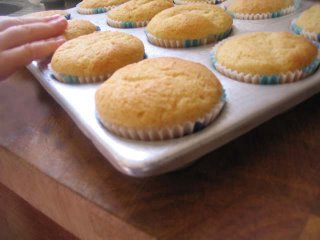Patty cakes

I started making these earlier in the week when we had a food scare at childcare. The kids had been served banana cake, I think it was someone's birthday. Hannah had been given something else, and she had grabbed someone else's slice of cake and may have taken a mouthful. I was horrified that it had happened - the staff at the centre know how serious this can be, but at the same time there was relief as there was no reaction. We have never known what might happen if she ingested egg or nuts because the allergy was picked up when she was so young. She reacted to the egg and peanut protein in breast milk, which was identified by a dermatologist because of the nature of her eczema. The allergy specialist said he couldn't tell what would happen were she to ingest egg or nuts, we were told to carry an epi-pen and be very careful. Hannah's next prick test is not until July, so I won't know for sure til then - but I'm am now desparately hoping that the egg allergy has disappeared.
However until we know for sure, life will still be egg-free. I realised I should have supplied the childcare centre with some egg-free cake so that Hannah wouldn't feel left out when cake was served. So I started experimenting with these. The photo is from my fourth batch which I thought worked the best so far. I'll now send a batch, individually bagged and labelled to the childcare centre for them to freeze and use as needed.
I'm not sure what to call them, in the original recipe from my Mum, they are patty cakes. I imagine now they would be called cup cakes, Hannah calls them muffins. They are baked in paper liners that are called patty pans, and then traditionally they would be iced or turned into butterfly or jelly cakes. They store well in a cake tin for a few days and freeze well.
In my mum's recipe the cream used is supposed to be soured, i.e. ordinary cream that has turned. She said it made no difference to the recipe if you used soured cream or fresh cream, so I guess it's an economy measure to use up cream that would otherwise be wasted. This recipe makes between 11 and 12 small cakes.
1/2 cup cream
1/2 cup castor sugar
3/4 cup plain flour
1 1/2 tsp baking powder
1/2 tsp vanilla
4 tbs milk
Beat the cream and sugar until the cream thickens. Gently mix in milk and vanilla, then add flour and baking powder and gently combine.
Place patty pan liners (or paper muffin cases) into patty-pan tray (muffin tray with 40ml capacity cups) and spoon 1 desertspoon of mix into each. Bake at 180 degrees C for between 20 and 25 minutes. Makes 12.

